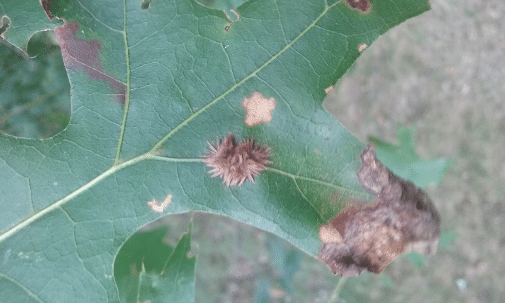Happy Gall-oween! Mwah-hahaha! Prepare yourselves for the silent invasion of the leaf galls! Over the summer and into the early fall, you may have seen something very strange happening to the oak trees of Southwestern Pennsylvania. Small, furry growths, brown or orange in color, have been appearing on oak leaves. If you haven’t seen them, imagine a Tribble from Star Trek, but in miniature size growing directly on the leaves of a shady oak.
These are leaf galls—but they aren’t an alien lifeform nor a devastating tree blight. They are the product of a fascinating chemical reaction.
Early in the spring, just as the oak trees are beginning to bud, gall wasps (from the family Cynipidae) lay their eggs on the brand-new leaves. These creatures—smaller than a fruit fly and lacking the ability to sting—might also lay their eggs on the twigs of the trees or on the stems of goldenrod. Once the wasp eggs hatch, the larvae begin to eat the leaf on which they were deposited. This is when things get interesting: when the chemicals in the larvae’s saliva mingle with the plant hormones in the leaf, the gall begins to form. Depending on the drop site and the species of gall wasp (there are over 700 species in the United States alone that target oaks), the appearance of the gall will be different. For instance, when the eggs hatch on a branch or twig and begin their feast, the gall will have a dense, spherical appearance. This is the specific kind of gall that gives the phenomenon its name: “galla” means “oak-apple” in Latin. Some leaf galls might take on the shape of tiny brown flying saucers as they did in Jefferson and Forest Counties in recent years. Some other galls have the appearance of spindly red fingers or peppers protruding from the leaf. The variety of tree and leaf galls are, in a word, kaleidoscopic.
While there is great variation in the physical appearance and structure of leaf galls, they each serve a shared purpose. The chemicals that the larvae secrete as they “chew” stimulate the leaf into creating a gall for shelter and sustenance. The gall is a protective, nutrient-providing dome over the developing larvae. While the galls sometimes interrupt the process of photosynthesis and cause some leaf browning and curling, they won’t kill the tree itself. The gall wasp is a mostly benign parasite. By mid-October, the wasp-bearing galls will fall from, or with, their leaves. The next spring, the surviving wasps will emerge from the soil.

Some years, this new generation will breed sexually. Other years, it will be entirely female and reproduce asexually. That is, through parthenogenesis, the same process that the dinosaurs in the original Jurassic Park reproduce. Remember Dr. Malcolm’s famous “life finds a way” monologue? Galls are misunderstood by the general public because they perceive the phenomenon as a nuisance and eyesore. Scientists warn against treating infested trees with pesticide or scraping off the galls. Such actions would do more harm than good to the trees. Instead of being an unnerving menace, the gall wasp is an awe-inspiring example of how one animal uses its surrounding ecosystem—without excessive harm—to ensure that its kind will perpetuate itself safely and successfully. Furthermore, the weirdly wonderful shapes and designs of the leaf gall demonstrate that nature isn’t just useful but also beautiful. It’s that beauty that makes this seemingly bizarre invader more than a seasonal annoyance.
Nicholas Sauer is a Natural History Interpreter and Gallery Experiences Presenter at the Carnegie Museum of Natural History. Museum employees are encouraged to blog about their unique experiences and knowledge gained from working at the museum.
